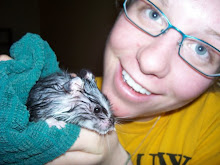Time's flying by like I can't believe! How is it March? Piglets on their way in only a month, new chicks in only two weeks, and of course LouAnne's still due to kid any day. The poor gal is unbelievably huge and carrying either three kids or two monster ones around on that very infected tibia. I finally gave up expecting her to kid at any moment and put Corona in with her to keep her company in the meantime. They're getting on suprisingly well and seem pretty peacable even when there's grain to fight over. LouAnne is top dog, but isn't rude about it, and God knows she deserves first pick of the food in her condition. Grandma's not burning many calories.
Speaking of which, my grain sprouting experiment is going smoothly, and I've completely transitioned the goats off their commercial diet and onto sprouted whole grains and seeds, bran mash, and brewer's grains. It's certainly more labor intensive than just popping open a feed bag and scooping away, but so far it's very satisfying to feed some healthy green material in the dead of winter. The chickens love it, but I'm only producing enough for them to get a gallon or so a day - just a snack for a hundred busy laying hens!
I've been finally getting down to business with culling and labeling the laying flock, but gave up on the seemingly much more efficient physical exam method. There is a lot of info on the web and in books explaining how to determine if a hen is laying efficiently or is old and ready to retire. The tell tale signs include a darkly pigmented beak and legs, narrow and stiff pelvic bones, small and pale comb, and gross/shrively/dry vent (as opposed to gross/wrinkly/moist vent, ew). Unfortunately, with every breed of chicken under the sun ranging in age from 7 months to 7 yrs, it was comparing apples and oranges. A barred rock is going to have a lot more pigment everywhere than a white leghorn, pelvic bone width is very dependant on the breed's size and shape, and the difference between an egg laying vent and a plain old pooping vent isn't very obvious.
I killed a good ten or twelve chickens, convinced that they were old and useless, only to find a bunch of eggs lining up to be laid. So, feeling much too guilty to continue the guessing game, even though those layers were probably not efficient layers, I've started separating small groups of birds and just waiting to see if they lay. I'm trying to get a white, green, and brown egg layer all in the test group at once to speed things up because I have a good sixty or seventy birds to work through. I tried a large white and small white bird the first time, but ended up with a medium white egg, and both birds sitting on it looking business-like now and then! I'm also banding birds I see in the hen house a lot if I notice them laying an egg. It's not a perfect system, and we're still going to have a few duds in the bunch, but it's progress towards a more efficient farm and a big learning experience as well!
I AM Daring Greatly
13 years ago

3 comments:
No wonder you are busy! There's a ton going on!
Thanks for blogging. I just love it.
Glad I found this! Can't wait to keep reading and share stories with you. I love someone else who shares the philosophy of "it's all one big crazy experiment"
Post a Comment